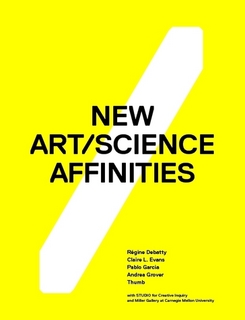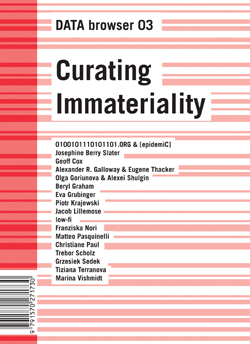The Hartware Guide to Irational.org (2006) [English/German]
Filed under catalogue | Tags: · art, copyright, intellectual property, internet, internet art, media art, net art

Published on the occasion of the exhibition “The Wonderful World of Irational.org. Tools, Techniques and Events 1996-2006” in the PHOENIX Halle Dortmund from 30. 08. till 29. 10. 2006, curated by Inke Arns and Jacob Lillemose.
“Irational is a loose grouping of six international net and media artists who came together around the server irational.org, founded by the British net artist Heath Bunting in 1996, going on to make decisive contribution to early net art from the mid-1990s onward. With dry humor and minimal aesthetics, irational commented the Internet hype of the mid-to-late 1990s, competing with the commercialization-euphoria of the new market by developing its own pseudo-ventures. Net art was immediate during this period, neither needing nor enjoying the safety of a mediating space or instance. This is why irational often hit upon humorless trademark attorneys, who wanted to keep irational from using brand names such as 7-11, American Express, Sainsbury’s and Tesco. These encounters, which the exhibition documents extensively, were little more than a prelude to more recent developments in the field of copyright, intellectual property, and brand protection. Heath Bunting was the first net artist to retire in 1997, putting an end to his exclusive work on the net and turning back to more intensive work in public space, which the Internet has become such an important part of today. If the activities of irational during its “net phase” were dedicated to calling virtual boundaries into question, its members now experiment with interrogating and overcoming economic, political, and social boundaries in real space, producing a great deal of comic relief, among other things.” (from the press release for the exhibition)
With texts by Susanne Ackers, Inke Arns, Matthew Fuller, Francis Hunger, Jacob Lillemose, Darija Šimunović
Editors Susanne Ackers, Inke Arns, Francis Hunger, Jacob Lillemose
Publisher Revolver – Archiv fuer aktuelle Kunst, Frankfurt am Main, October 2006
ISBN 3865882994, 978-3865882998
136 pages
PDF (6 MB, updated on 2023-3-10)
Comment (0)Grover, Debatty, Evans, Garcia, Thumb: New Art/Science Affinites (2011)
Filed under sprint book | Tags: · art, bio art, biotechnology, hacking, maker culture, media art, programming, science, subversion, technology

The Miller Gallery at Carnegie Mellon University and the STUDIO for Creative Inquiry have co-published “New Art/Science Affinities,” a 190-page book on contemporary artists that was written and designed in one week by four authors (Andrea Grover, Régine Debatty, Claire Evans and Pablo Garcia) and two designers (Luke Bulman and Jessica Young of Thumb).
“New Art/Science Affinities,” which focuses on artists working at the intersection of art, science and technology, was produced by a collaborative authoring process known as a “book sprint.” Derived from “code sprinting,” a method in which software developers gather in a single room to work intensely on an open source project for a certain period of time, the term book sprint describes the quick, collective writing of a topical book.
The book includes meditations, interviews, diagrams, letters and manifestos on maker culture, hacking, artist research, distributed creativity, and technological and speculative design. Chapters include Program Art or Be Programmed, Subvert! Citizen Science, Artists in White Coats and Latex Gloves, The Maker Moment and The Overview Effect.
Sixty international artists and art collaboratives are featured, including Agnes Meyer-Brandis, Atelier Van Lieshout, Brandon Ballengée, Free Art and Technology (F.A.T.), Rafael Lozano-Hemmer, The Institute for Figuring, Aaron Koblin, Machine Project, Openframeworks, C.E.B. Reas, Philip Ross, Tomás Saraceno, SymbioticA, Jer Thorp, and Marius Watz.
The authors collectively wrote and designed the book during seven, 10-14 hour-days in February 2011 at the STUDIO for Creative Inquiry. During their sessions they held conversations with CMU faculty, staff and students from the STUDIO, Miller Gallery, College of Fine Arts, Robotics Institute, Machine Learning Department and BXA Intercollege Degree Program.
“The book sprint method was adopted in order to understand this very moment in art, science and technology hybrid practices, and to mirror the ways Internet culture and networked communication have accelerated creative collaborations, expanded methodologies, and given artists greater agency to work fluidly across disciplines,” says lead author Andrea Grover.
The publication is part of Grover’s Andy Warhol Foundation for the Visual Arts Curatorial Research Fellowship at CMU’s STUDIO for Creative Inquiry and Miller Gallery. “Intimate Science,” an exhibition that will be the product of Grover’s research, will take place in early 2012 at the Miller Gallery.
Published by Miller Gallery at Carnegie Mellon University + CMU STUDIO for Creative Inquiry, October 2011
ISBN 0977205347
190 pages
Licensed under Creative Commons Attribution-NonCommercial-NoDerivs 3.0 License
commentary (We-Make-Money-Not-Art.com)
authors
Joasia Krysa (ed.): Curating Immateriality: The Work of the Curator in the Age of Network Systems (2006)
Filed under book | Tags: · aesthetics, art, collaboration, curating, database, exhibition, internet, internet art, labour, media art, museum, net art, open source, relational aesthetics, software art, technology

“The site of curatorial production has been expanded to include the space of the Internet and the focus of curatorial attention has been extended from the object to processes to dynamic network systems. As a result, curatorial work has become more widely distributed between multiple agents, including technological networks and software. This upgraded ‘operating system’ of art presents new possibilities of online curating that is collective and distributed — even to the extreme of a self-organising system that curates itself. The curator is part of this entire system but not central to it.
The subtitle of the book makes reference to the essay ‘The Work of Culture in the Age of Cybernetic Systems’ (1988), in which Bill Nichols considered how cybernetics transformed cultural production. He emphasised the shift from mechanical reproduction (symbolised by the camera) to that of cybernetic systems (symbolised by the computer) in relation to the political economy, and pointed to contradictory tendencies inherent in these systems: ‘the negative, currently dominant, tendency toward control, and the positive, more latent potential toward collectivity’. The book continues this general line of inquiry in relation to curating, and extends it by considering how power relations and control are expressed in the context of network systems and immateriality.
In relation to network systems, the emphasis remains on the democratic potential of technological change but also the emergence of what appears as more intensive forms of control. Can the same be said of curating in the context of distributed forms? If so, what does this imply for software curating beyond the rhetoric of free software and open systems?”
Contributors: 0100101110101101.ORG & [epidemiC] | Josephine Berry Slater | Geoff Cox | Alexander R. Galloway & Eugene Thacker | Olga Goriunova & Alexei Shulgin | Beryl Graham | Eva Grubinger | Piotr Krajewski | Jacob Lillemose | low-fi | Franziska Nori | Matteo Pasquinelli | Christiane Paul | Trebor Scholz | Grzesiek Sedek | Tiziana Terranova | Marina Vishmidt
Publisher Autonomedia/I-DAT, 2006
Creative Commons License
DATA browser series, 3
ISBN 1570271739
288 pages
PDF (14 MB, added on 2018-3-29)
PDFs (updated on 2016-12-12)

